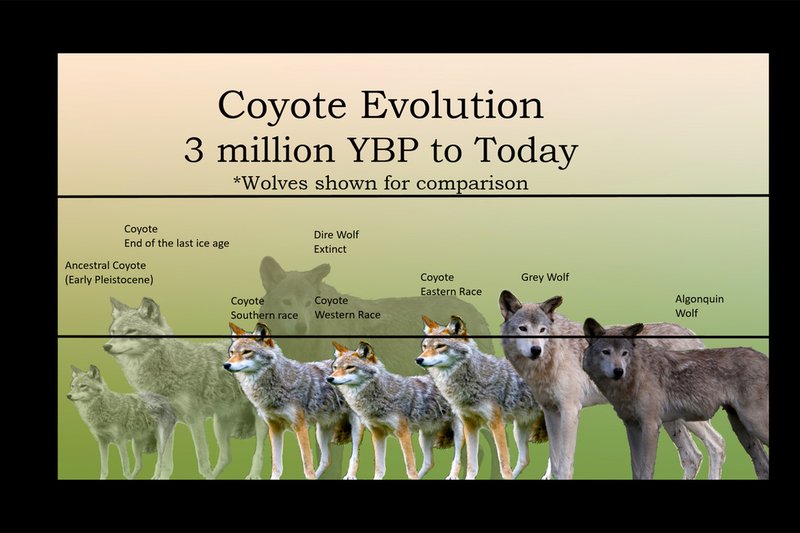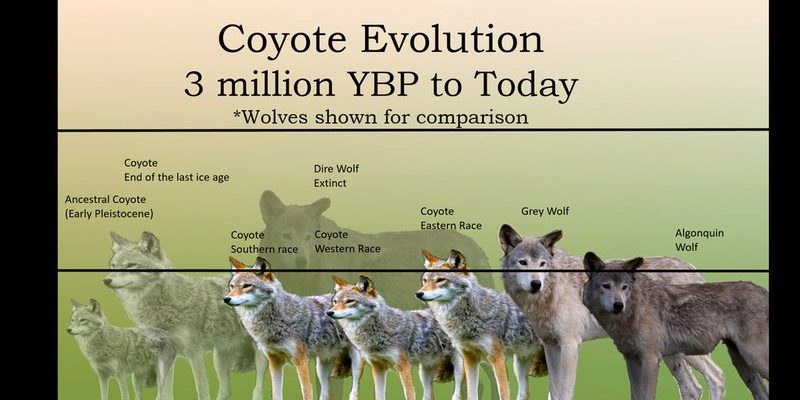
Coyotes belong to the family Canidae, which includes dogs, wolves, and foxes. Picture a family reunion for these animals, where each member has their own quirks but shares a common ancestry. Understanding the coyote’s evolutionary story helps us not only appreciate their role in nature but also provides insights into how they interact with their environment and other species, including us humans.
Where Do Coyotes Come From?
Coyotes (Canis latrans) have a rich lineage that can be traced back to their ancestry millions of years ago. Their story starts with early canids, which roamed North America around 40 million years ago. These primitive relatives were different from what we think of as dogs today. They looked more like small foxes and were heavily influenced by the changing landscapes of their time.
Around 10 million years ago, the first true canids appeared. These include species that would eventually lead to modern dogs and wolves. As these animals evolved, they adapted to different climates and terrains, leading to a diverse range of traits. One of those branches was the coyote, which emerged during the late Pleistocene, around 1 million years ago.
Coyotes began to flourish across North America, thanks in part to their adaptability. They were able to thrive in a variety of ecosystems, from deserts to forests to urban areas. This flexibility is one reason you’ll find them in so many different habitats today.
The Rise of the Coyote
As the last Ice Age ended, the landscape of North America began to change dramatically. Many larger animals, like mammoths and saber-toothed cats, went extinct. This was a golden time for coyotes, who could fill the ecological gaps left behind. With fewer competitors, they adapted even more, becoming smaller and more agile.
Coyotes began to develop a more varied diet compared to their ancestors. While their larger relatives relied on big game, coyotes became opportunistic feeders, meaning they could eat almost anything. From small mammals like rabbits and rodents to fruits and garbage, their diet is as diverse as their habitats. This adaptability not only helped them survive but also thrive in new environments.
What’s fascinating is how their social structures changed too. Historically, coyotes lived in packs, much like wolves. However, as they adapted to human-altered environments, many coyotes started living more solitary lives or in small family groups. This shift has allowed them to occupy urban areas, where food sources are plentiful, yet competition can be high.
Coyotes and Humans: A Complicated Relationship
The coyote’s relationship with humans has been a tricky one. Early settlers viewed them as pests and often hunted them to protect livestock. This led to widespread culling, but surprisingly, it didn’t diminish their populations. Instead, it had the opposite effect. The absence of larger predators allowed coyotes to expand even further into new territories.
You might be wondering how this all works. When coyotes are hunted, the remaining members of their population tend to breed more. This increased reproduction rate and their ability to adapt means that they bounce back quickly, even in the face of human intervention. It’s almost like nature has set up a little safety net for them.
Today, coyotes are found all over North America and even into parts of Central America. Their ability to adapt to urban areas means they’re often spotted in cities, scavenging through trash or roaming suburban neighborhoods. While some people welcome their presence as part of the natural ecosystem, others view them as a nuisance.
Adaptations That Set Coyotes Apart
Coyotes are built for survival. Their physical adaptations have played a significant role in their success as a species. For instance, they have long legs and a slender body, allowing them to run fast and cover large distances. Imagine being able to sprint through fields and forests while maintaining agility; that’s what coyotes do.
Their keen sense of hearing and smell makes them exceptional hunters. They can detect prey from miles away, and their ability to communicate through vocalizations helps them coordinate during hunts. Sometimes, they even use a clever trick of howling to confuse prey or signal each other about food sources.
The coyote’s coat is another remarkable adaptation. Its fur can blend into a variety of environments, from rocky terrains to urban settings. This camouflage not only protects them from predators but also helps them sneak up on unsuspecting prey.
The Future of Coyotes
As we look to the future, the coyote’s evolutionary journey is still ongoing. They’re continually adapting to changing environments, including urbanization and climate change. Many scientists believe that coyotes will play a crucial role in maintaining ecological balance, especially in urban areas where they help control rodent populations.
But with their expanding range comes challenges. Conflicts between coyotes and humans may rise, leading to calls for management and control. Educating the public about coexisting with coyotes is more important than ever. For instance, keeping pets safe and securing trash can significantly reduce unwanted interactions.
The ongoing study of coyotes also provides valuable insights into wildlife management and conservation. By understanding their behavior and ecology, we can learn how to protect not just coyotes but also other wildlife that shares their habitats.
The evolutionary history of the coyote is a testament to resilience and adaptability. From their humble beginnings millions of years ago to their current role in diverse ecosystems, they’ve proven their ability to thrive against the odds. Whether you’re witnessing a coyote on a hike or hearing their calls at night, you’re experiencing a piece of a rich and fascinating story.
Understanding coyotes helps us appreciate their importance in the natural world. They remind us that nature is constantly evolving and that each species plays a unique role in the web of life. So next time you hear a coyote howling, think of the long journey they’ve taken to get here, and appreciate the wild spirit they embody.

